Car Dies While Driving But Restarts [I fixed after cleaning throttle body]
If your car dies while driving but restarts, there might be issues with some parts. The battery might be too weak to keep the engine running. Or the starter may be having trouble turning over the engine. The serpentine belt could slip or break, stopping things like the alternator and AC. Check for cracks and wear. Problems in the wiring harness can cut power to parts of the engine. Look for damaged or loose wires. A bad ignition switch won’t send power to start the car or keep it running. They tend to wear out over time. The alternator recharges the battery while driving. If it fails, the battery can’t keep the engine going. Issues with the throttle body or mass airflow sensor can disrupt proper airflow and cause stalling. Sensors like the crankshaft position sensor help control engine timing. If they malfunction, the engine can cut out. The ignition coil provides the spark for combustion. No spark means no start. Finally, blockages in the fuel line or fuel pump failure can cause fuel starvation, stalling the engine.
A car that turns off while driving but starts again after some time could have many reasons for this. Some reasons might be mechanical. Some might be electrical. Maybe a part broke. Or some wires went bad.
In this guide, I’ll discuss some most common reasons that cause your car to turn off occasionally while driving.
You should plug in an OBD2 scanner. This will read any error codes saved in the car’s computer. Finding the codes can help figure out why the engine cuts out on the road.
You can also read my guide on why my car starts sometimes and sometimes it doesn’t.
- Engine stalling or dying while driving can indicate serious issues like battery, alternator, throttle body or MAF sensor problems.
- Faulty electrical connections to ground and starter or bad ignition coils can cause intermittent stalling.
- Clogged fuel filter, bad fuel injectors or failing fuel pump reduces fuel supply leading to stalling.
- Worn serpentine belt can affect alternator charging resulting in low battery power and stalling.
- Carbon buildup in throttle body or bad cam phaser interrupts air flow causing engine to die while driving.
Causes Of Car Dying While Driving
Here are some of the most common causes of car dying while driving.
1. Failed Car Battery To Provide Power
The battery is the most common reason for a car dying while driving. The battery gives power to all the engine sensors and other electrical stuff.
The sensors send signals to the car’s computer to check the engine operating parameters.
If the battery in your car is old, it might not be able to start your engine. This could make your car not start at all, or the engine starts but then stops going.
A healthy battery has a voltage of:
- 12.6V when fully charged and the engine is off
- 13.5 to 14.5V when the engine is running
- 9.6 to 10V when the engine just cranks before starting (it drops to 9.6V for a couple seconds when cranking). As the engine starts going, the alternator gives current to the battery.
How to check?
The battery’s power should be checked with a voltmeter when the car is having problems. The red wire from the voltmeter needs to touch the plus side of the battery. The black wire needs to touch the minus side.
If the battery shows less than 13.5 volts while the engine is on, the battery or alternator has an issue. The battery or alternator is not working right.
Next, do a load test on the battery. Have someone start the engine while you watch the voltmeter. Note the volts at that exact moment. The battery should not go less than 9.6 volts during this test.
2. Loose Battery Terminals Causing Voltage Drops Due To Additional Resistance
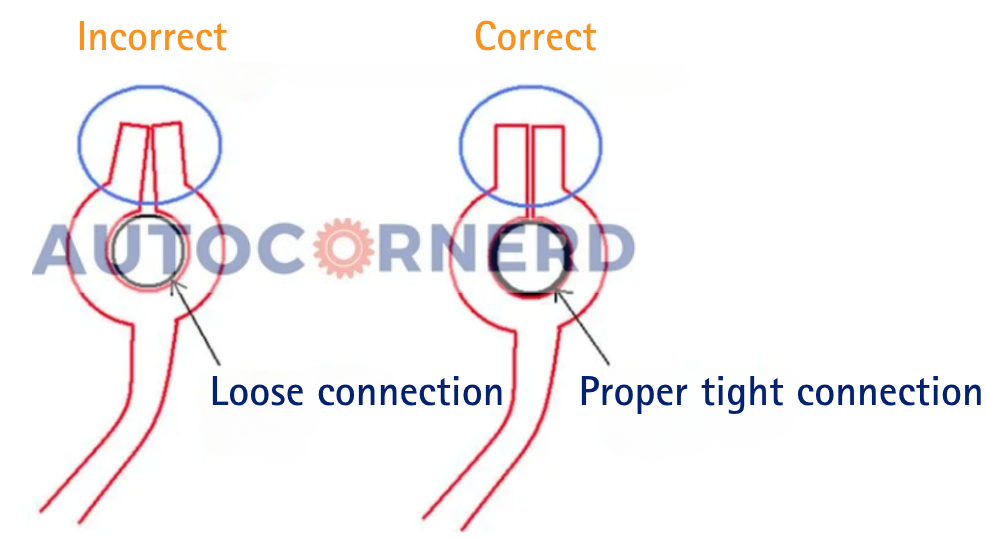
Loose battery terminals can stop your car while driving. The battery terminals are metal posts that connect the battery to the car’s power system. Over time, they get rusty or loose. This causes problems.
If the terminals are loose, power won’t flow well from the battery to the engine’s computer, starter, and sensors. Resistance makes power drop too much. Then your car shuts off while driving.
In my guide on car won’t start after changing battery, you can learn more about loose battery terminals.
3. A Bad Alternator Is Not Charging The Battery
The alternator works like a generator. It makes power to charge the car battery when the engine runs.
The alternator gets power from the engine. The engine power goes to the alternator through the serpentine belt. The serpentine belt goes around the crankshaft pulley. The pulley gives power to the alternator pulley.
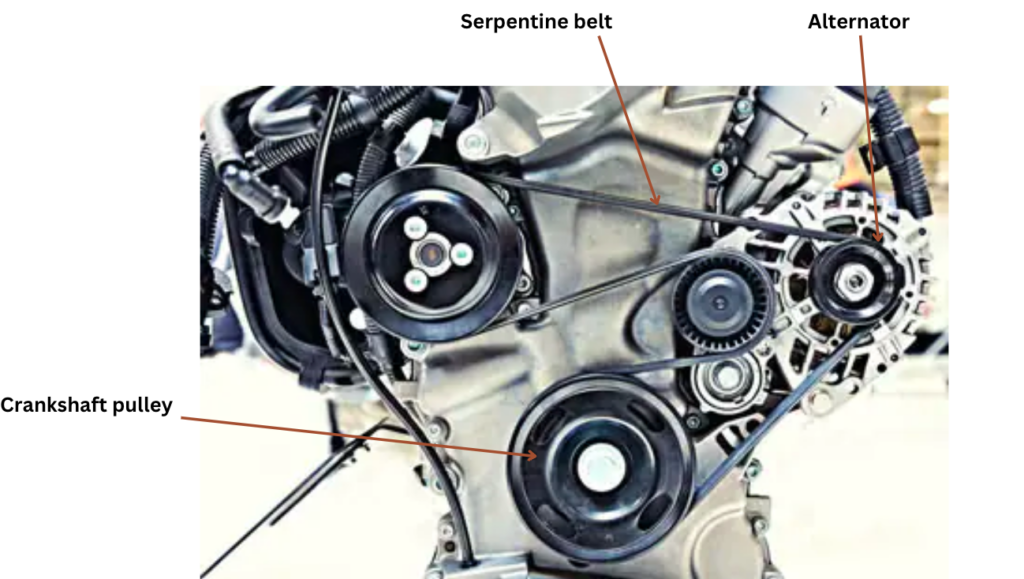
The alternator keeps the battery charged up. It also gives power to the engine parts while the engine runs. If the alternator goes bad, the battery will die. Then the car will turn off while driving.
If the battery voltage is less than 13.5V when the engine runs, the alternator is bad or the serpentine belt is damaged.
The symptoms of a bad alternator that is not charging the battery include:
- Alternator is overheated and begins to smell. You should check the settings of voltage regulator. If the voltage setting is below 13.5V, it will cause overheating of the alternator due to a large amount of current flowing through it.
- Charging lamp (battery light) will light on the dashboard
- Charging lamp does not turn off after start. When the engine is started, the charging lamp turns on for a couple of seconds to indicate that the lamp is working fine. If it does not turn off after a few seconds of starting the car, it probably means there’s something wrong with the alternator.
- The alternator is flooded with oil. In that case, you should check the surroundings of the alternator.
- The fuse is blown.
- The cable or plug of the alternator is rusty.
- Rust can also develop in the alternator due to clearance between the stator and rotor of the alternator. It will also seize the alternator.
To learn more, you can read my guide on how car keeps killing or burning alternator.
How to fix?
If the alternator is seized i.e. its pulley is not rotating freely, you should put a breaker bar on the nut of the alternator pulley, and try to force it to turn, forward and backward. You can also spray a wicking coil into the winding of the alternator from the pulley side to fix a seized alternator.
4. Damaged Serpentine Belt
A damaged serpentine belt can make your car shut off when driving but start again.
The serpentine belt moves the engine’s power from the crankshaft to parts like the water pump, AC compressor, and alternator.
When the serpentine belt is too tight or too loose, the alternator won’t make electricity to charge the battery.
If the serpentine belt is damaged, you’ll hear clicking noises from the engine. Also, if the serpentine belt is loose, it can’t efficiently move power from the engine to the alternator.
The serpentine belt has a tensioner and an idler pulley. The pulley might not spin smoothly and have side-to-side play. This can stop the serpentine belt from stretching.
Check out the below video to learn about the failure models of the serpentine belt.
5. Damaged Electrical Connections To The Ground and Starter
The electricity in your car flows through wires. When there is a problem with the wires, the electricity can’t flow well. Then your car may stop working sometimes.
There are some things that can cause problems with the electricity. The wires might be loose. Or the connectors might be rusty. Or there could be a short circuit. Or a break in a wire.
The negative terminal of the battery is grounded to the engine block and metal parts. You need to look at those connections. See if they are good.
How to test?
To test the ground connections of your car, take a voltmeter. Connect one probe with the negative terminal of the battery and the other on the engine block or chassis.
If the connections are fine, there will be less than 0.2 volts recorded on the voltmeter when trying to start an engine. If you can see any voltage, it means battery ground connections are damaged.
In some engines, there is also a ground strap connection between the car body and the engine. Its ends are usually mounted on the transmission and car body. If the ground strap is weak or torn in any way, it could also car not to start.
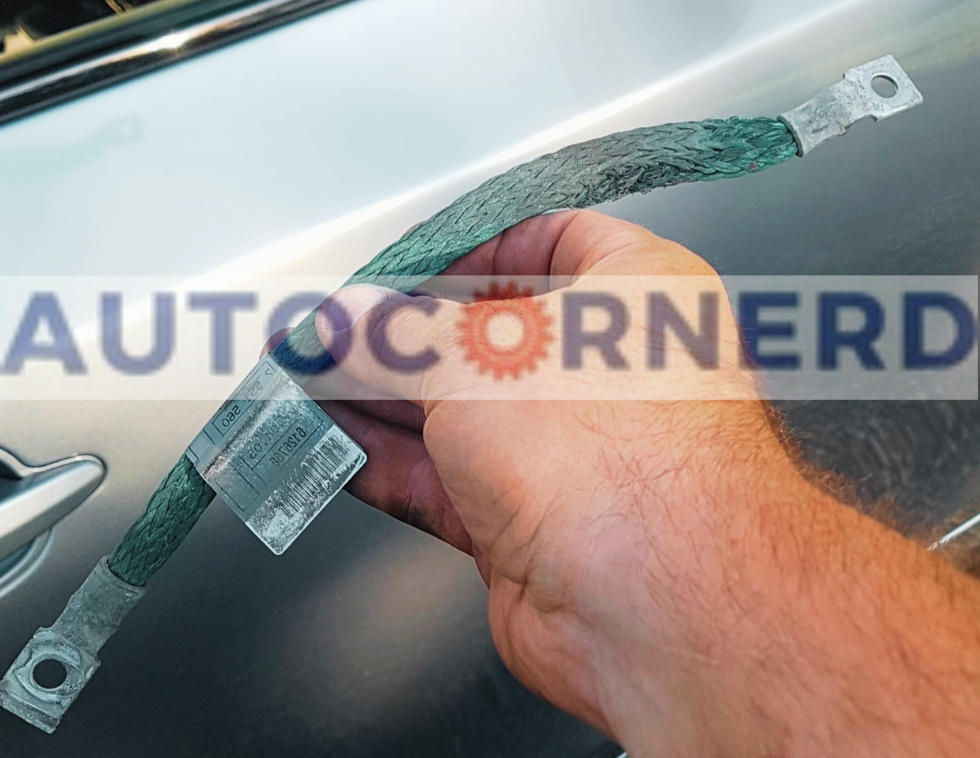
Now, repeat the test by connecting a probe voltmeter with the positive terminal of the battery and another probe with the solenoid terminal of the starter.
Ideally, there should be no voltage drop across the battery-positive terminal and starter solenoid terminal (also called S terminal) i.e. there should be negligible resistance in the circuit. So, if the connections are good, the voltmeter will show a voltage of less than 0.2V.
6. Bad Throttle Body Restricting Optimum Airflow
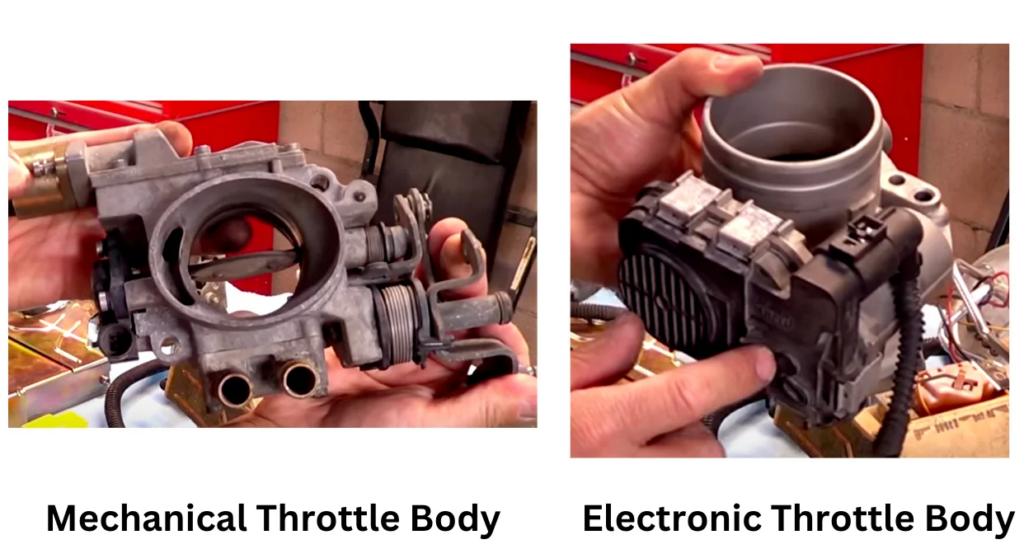
A bad throttle body can also car your car to die out while driving due to its sticking throttle valve, leading to improper airflow.
The throttle body of an engine regulates the amount of air to enter the engine’s cylinder based on the position of the accelerator pedal. It has a butterfly valve that is mechanically or electronically controlled, depending on the engine.
The mechanical throttle body is driven by a throttle cable that links the accelerator pedal to the throttle plate. If the throttle cable is too tight or sticking a little, it will not be able to have full control over the throttle plate. As a result, your car engine’s RPM will boggle without pushing a gas pedal.
The electronic throttle body is controlled by the ECU. The accelerator pedal sensor sends signals to the ECU so that it can compute how much the throttle valve should be opened.
When the throttle body is not working properly, it can cause the car to stall and eventually die out while driving. This can happen for a number of reasons, but the most common cause is a build-up of carbon deposits on the throttle body. Over time, these carbon deposits can build up and restrict the airflow to the engine, causing the car to lose power and eventually die out.
Also, carbon deposits in the throttle body prevent the butterfly valve to rotate freely under the action of a spring.
How to test?
The throttle body has a port where a wire connector plugs in.
You have to test the voltage signals at the wire connector of the throttle body. Also test the resistance between the terminals of the throttle actuator. In my P1516 code guide I explained how to test the throttle body.
If the throttle body passes the electrical tests, check inside for carbon buildup. Use throttle body cleaner to clean it. Make sure the throttle plate moves freely when you move it with your finger.
The butterfly valve of the throttle body should turn freely with spring force. After cleaning, do the ECU relearn procedure for the electronic throttle body. I explained the relearn procedure in my P1516 code guide I linked above.
7. Bad MAF Sensor Failing To Calculate Correct Airflow
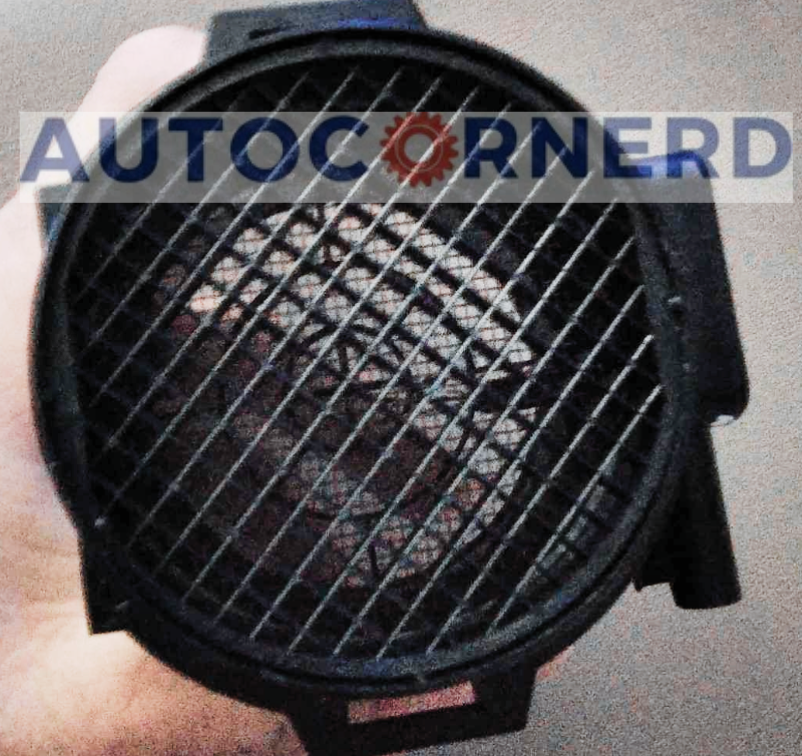
The MAF sensor measures the air entering the engine. This allows the right fuel mix for smooth driving. If the MAF sensor fails, the engine can die while driving.
The engine needs the right air-fuel mix to run properly. If the MAF reading is wrong, the ECU can’t decide how much fuel needs to be injected. As a result, the engine gets the wrong fuel amount. This makes the engine die while driving.
Note: Keep in mind that older engines have a Manifold Pressure (MAP) sensor instead of a MAF sensor. So, it depends on which engine you have. The MAP sensor cannot be cleaned. So, you have to replace it.
How to test?
If you want to test your MAF sensor, you can check the voltage it produces. When you press the gas pedal, more air flows through the sensor, which makes the voltage go up. When the car is not moving much, the voltage should be less than 1.0V. But when you speed up, the voltage from the MAF sensor goes up to around 1.7V.
How to fix?
You can try cleaning the MAF sensor.
To clean the MAF sensor, follow these steps:
- Disconnect the negative terminal of the battery.
Remove the MAF sensor, it is located on the intake tube between the air filter box and the throttle body of the engine. - Spray all of the little sensors you see inside of the MAF carefully with this MAF sensor cleaner. Avoid touching the wires of the MAF sensor. It will damage it.
- Reinstall and reconnect the battery terminal.
- Start the engine and let the ECU relearn idle for 15 minutes.
I found the following Youtube video helpful for cleaning the MAF sensor:
Before testing the MAF sensor, you also have to visually inspect and test the harness connector of the MAF sensor for any intermittent electric connection. If the car restarts again after stalling, it usually indicates intermittent electric faults in the circuit.
You can watch the below video for a better understanding of the testing of the MAF sensor:
8. Bad or Clogged Fuel Injector Not Injecting Optimum Amount Of Fuel
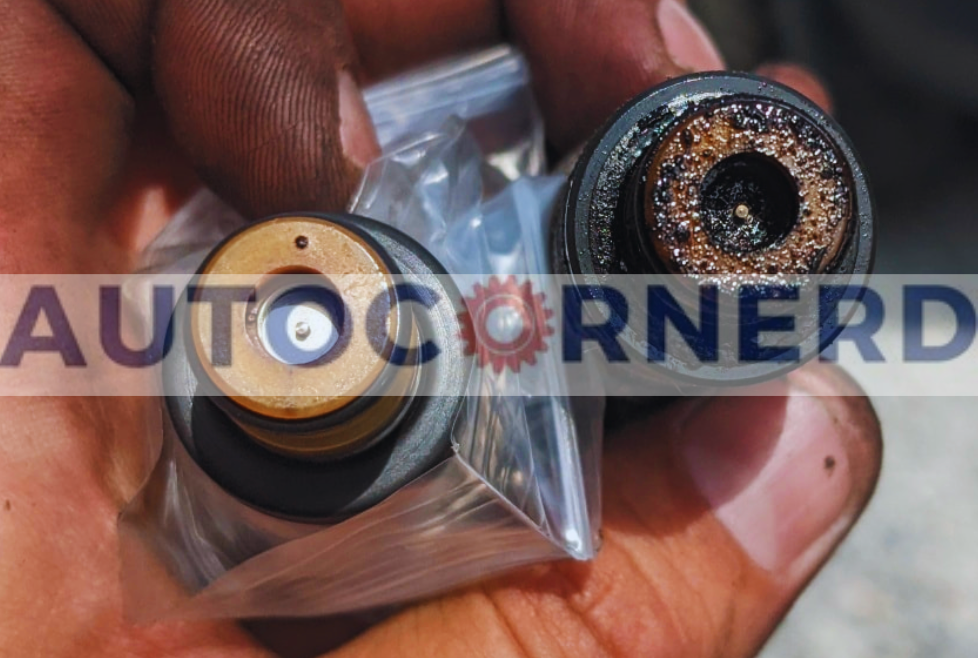
There are a few signs that your fuel injector is going bad. If you notice any of these, it’s time to get it checked out.
- Your car is hard to start: If your car takes more time than usual to start, or if it seems difficult to start, this could hint that the fuel injector is wearing out.
- Your car is running rough: If the engine seems uneven or misfires sometimes, it’s another sign of the injector going bad.
- Your car is stalling: If the engine cuts out on its own, it clearly shows the injector needs attention.
- Your car is getting poor gas mileage: If you notice lower gas mileage, the injector could be clogging up fuel flow.
- Your check engine light is on: It’s wise to get your car inspected if the check engine light turns on, as it may indicate injector problems.
When dirty or clogged, the fuel injector restricts fuel flow to the engine. This progressively worsens performance until the engine stalls.
A fuel injector sprays fuel into the engine in a specific way. This sprays the right amount of fuel where it needs to go. When an injector gets stuck open, it can’t spray the fuel properly anymore. This means too much fuel gets into the engine. Now there is too much fuel compared to air. This extra rich mix kills the engine and makes it stall. Fuel injectors have to spray fuel in just the right way for the engine to keep running. When fuel injector fails, it loses this precise control. And that makes the engine die.
You can read my guide on car won’t start after changing the fuel injector to learn how fuel injectors become bad.
9. Clogged Fuel Filter Restricting Fuel Flow
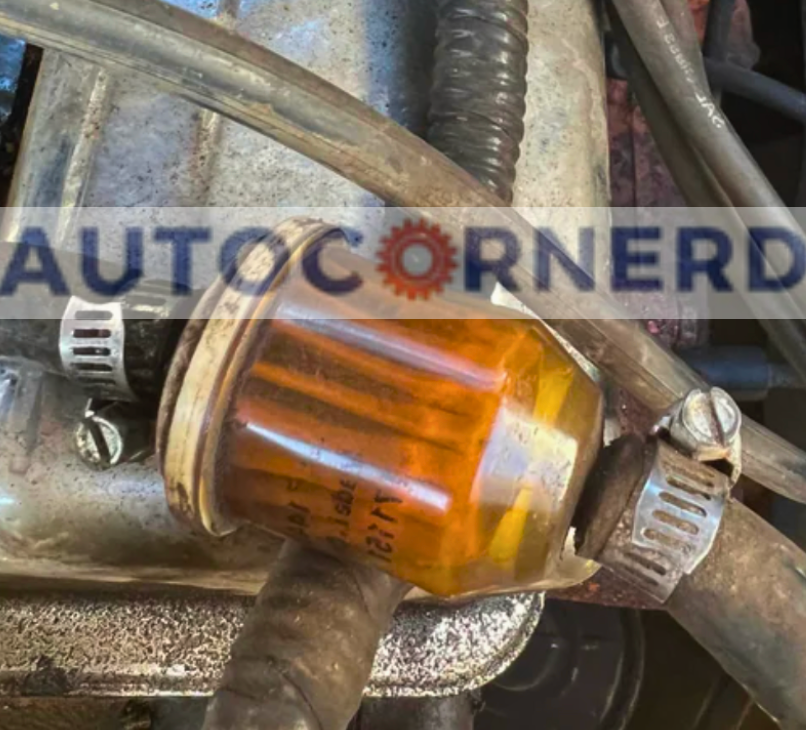
The fuel filter is responsible for keeping the fuel in your car clean. Over time, it can become clogged with dirt and debris. When this happens, the fuel can’t flow through the filter properly. This can cause the engine to stall or even turn off.
A fuel filter (fine filter) is installed after the fuel pump. Before the fuel pump, there might also be a strainer (coarse filter) to prevent debris in the fuel from being able to lock up the fuel pump.
How to test?
Before attempting this test, be sure to drain all gasoline from the fuel filter to avoid any potential hazards.
For the test, you’ll need a straw (to avoid ingesting gasoline) and the fuel filter itself.
- Slide the straw over the inline connection, carefully ensuring a tight connection that won’t obstruct airflow.
- Blow into the straw and observe if the air flows through the filter effortlessly or encounters obstruction.
If air flows through the fuel filter without any hindrance, the fuel filter is in good condition. However, if the airflow is slow or blocked, it indicates a faulty fuel filter that needs to be replaced.
10. Bad Ignition Coils Not Delivering Enough Voltage for Spark
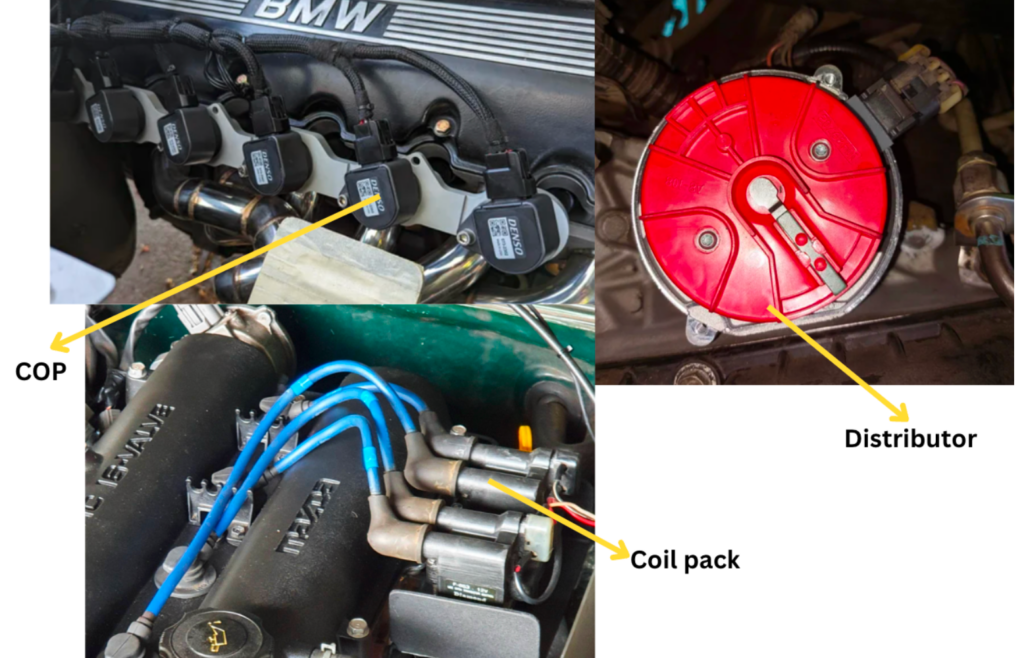
Ignition coils in an engine are responsible to convert a 12V from the battery into thousands of volts to generate a spark from a spark plug. If the ignition coil is getting an intermittent supply of current, your car may shut down while driving and then restart again.
The configuration of ignition coils depends on the engine. Modern engines have an ignition coil on each spark plug (also called COP configuration). Older engines have only one ignition coil that supplies voltage to all spark plugs through the distributor cap. In that case, you have to check for carbon and oil deposits inside the distributor cap.
Furthermore, the contacts on the cap and rotor of the distributor wear down over time due to high voltages and crossfire. The rotor can also wear down over time, which can cause it to make poor contact with the contacts inside the distributor cap.
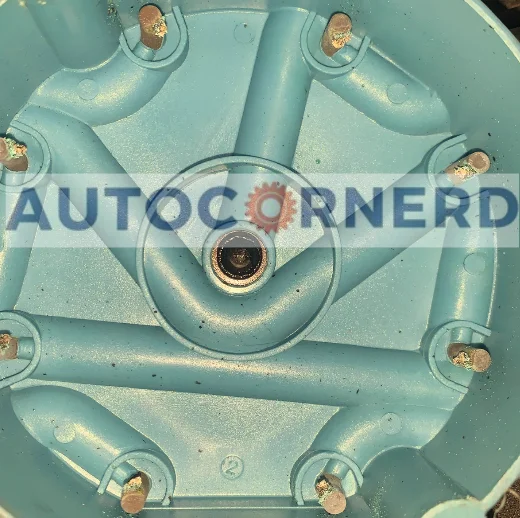
How to spot?
If your vehicle has COP, the best way to check bad ignition coils is to swap the ignition coil with another cylinder’s coil and see if the trouble code changes.
Another way to check a bad ignition coil is that if you remove the ignition coil of a certain cylinder and the engine starts to stumble, it means the ignition coil is good. If engine stays same, it means the ignition coil is bad.
11. Faulty Ignition Switch and Relay
The ignition switch can make your car die suddenly while driving. This little part turns the engine on when you put in and twist the key.
If gunk builds up in the ignition switch over time, it can interrupt the electrical connection and abruptly shut off the engine while driving.
Behind the ignition lock is a delicate switch made of metal pieces that can corrode with age. This corrosion can disrupt contact over time.
The ignition relay controls the electrical flow. It can also fail and stop working right. You can find ignition relay in the fuse box. Its exact location depends on make and model of your vehicle.
Both parts have important jobs turning on the ignition. Damage or wearing out could cause trouble starting up.
12. Bad Cam Phaser
Cam phasers are used in variable valve timing engines to adjust the opening and closing of the engine’s inlet and exhaust valves at higher speeds.
There are a few symptoms of a bad cam phaser, including:
- The engine is stalling
- The engine is hard to start
- The engine running rough
- The engine misfiring
- The check engine light is on
There are a number of reasons why your cam phaser may not be working properly. One possibility is that the cam phaser is dirty or damaged. Another possibility is that the cam phaser is not properly lubricated due to a clogged VCT solenoid that supplies oil under pressure to the cam phaser.
Some First Hand Experiences Shared By Users In Different Communities
Our team conducted research across various online communities, forums, and subreddits to gather user comments and opinions on “car stalls or dies out while driving”.
User 1 says:
Experienced this with my E320. Initially, I was baffled. After a diagnostic check, it turned out to be a bad mass airflow sensor. Replaced it and the car’s been running smoothly.
User 2 says:
My CRV had this issue. It was a clogged fuel filter. Replaced it myself after watching a few videos. It’s been running without any hiccups since then.
User 3 says:
Some cars have a smartphone app that connects to your vehicle. Check if your car has an app and see if remote start is one of the features listed there.
User 3 says:
Had a similar issue with my ’98 Miata. It died mid-drive but restarted after a few tries. Turned out to be a faulty crankshaft position sensor. Replaced it myself after watching a YouTube tutorial. Car’s been running smooth since.
User 4 says:
Had this scary experience with my Volvo XC90. Turned out to be an electrical issue related to the ECM (Engine Control Module). A software update from the dealership fixed it.
User 5 says:
I drive a Ford F-150, and it started dying out randomly on the road. Initially, I was baffled. It turned out to be an issue with the fuel pump. A mechanic friend of mine suggested checking the fuel pressure, and sure enough, it was low. Replacing the fuel pump fixed the problem.
How did you fix your car stalling issue while driving? Please vote.
[yop_poll id=”18″]
